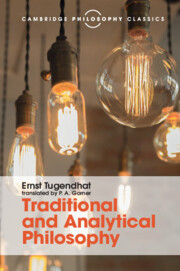Book contents
- Frontmatter
- Dedication
- Contents
- Preface
- Preface
- Translator's preface
- Part I Introduction: confrontation of analytical philosophy with traditional conceptions of philosophy
- Part II A first step: analysis of the predicative sentence
- 8 Preliminary reflections on method and preview of the course of the investigation
- 9 Husserl's theory of meaning
- 10 Collapse of the traditional theory of meaning
- 11 Predicates: the first step in the development of an analytical conception of the meaning of sentences. The dispute between nominalists and conceptualists
- 12 The basic principle of analytical philosophy. The dispute continued. Predicates and quasi-predicates
- 13 The meaning of an expression and the circumstances of its use. Dispute with a behaviouristic conception
- 14 The employment-rule of an assertoric sentence. Argument with Grice and Searle
- 15 Positive account of the employment-rule of assertoric sentences in terms of the truth-relation
- 16 Supplements
- 17 ‘And’ and ‘or’
- 18 General sentences. Resumption of the problem of predicates
- 19 The mode of employment of predicates. Transition to singular terms
- 20 What is it for a sign to stand for an object? The traditional account
- 21 The function of singular terms
- 22 Russell and Strawson
- 23 What is ‘identification’?
- 24 Specification and identification. Specification and truth
- 25 Spatio-temporal identification and the constitution of the object-relation
- 26 Supplements
- 27 Results
- 28 The next steps
- Bibliography
- Index of names
- Index of subjects
24 - Specification and identification. Specification and truth
from Part II - A first step: analysis of the predicative sentence
Published online by Cambridge University Press: 05 August 2016
- Frontmatter
- Dedication
- Contents
- Preface
- Preface
- Translator's preface
- Part I Introduction: confrontation of analytical philosophy with traditional conceptions of philosophy
- Part II A first step: analysis of the predicative sentence
- 8 Preliminary reflections on method and preview of the course of the investigation
- 9 Husserl's theory of meaning
- 10 Collapse of the traditional theory of meaning
- 11 Predicates: the first step in the development of an analytical conception of the meaning of sentences. The dispute between nominalists and conceptualists
- 12 The basic principle of analytical philosophy. The dispute continued. Predicates and quasi-predicates
- 13 The meaning of an expression and the circumstances of its use. Dispute with a behaviouristic conception
- 14 The employment-rule of an assertoric sentence. Argument with Grice and Searle
- 15 Positive account of the employment-rule of assertoric sentences in terms of the truth-relation
- 16 Supplements
- 17 ‘And’ and ‘or’
- 18 General sentences. Resumption of the problem of predicates
- 19 The mode of employment of predicates. Transition to singular terms
- 20 What is it for a sign to stand for an object? The traditional account
- 21 The function of singular terms
- 22 Russell and Strawson
- 23 What is ‘identification’?
- 24 Specification and identification. Specification and truth
- 25 Spatio-temporal identification and the constitution of the object-relation
- 26 Supplements
- 27 Results
- 28 The next steps
- Bibliography
- Index of names
- Index of subjects
Summary
The attempt to clarify Strawson's vague talk of ‘identification’, which at first seemed to correspond to what I had called the specificatory function of singular terms, led to the following result. What is thereby intended is not the general concept of specification, but a pre-eminent special case of this function by means of which is indicated at a lowest level which object is meant, that is, in such a way that the question ‘And which object is the one thus specified?’ can no longer be repeated. And it emerged that in the case of perceptible objects this special case of specification is only given when the object is spatio-temporally located by the singular term. However, we have so far not succeeded in describing this special case of specification in a way that would justify speaking of a clear concept of identification. It therefore also remained unclear what relevance this special case has for specification in general and hence for the possibility of referring to objects. And equally it remained unclear how this identification – specification by spatio-temporal location – actually functions and in what way spatio-temporal location has such a pre-eminence for the ultimate specification of a perceptible object.
At the end of the last lecture I referred to three methodological perspectives which can guide us in answering these questions which still remain open:
1. the orientation towards the actual mode of employment of singular terms and, in particular, towards the question of how it is to be established for which object the expression stands.
2. consideration of the fact that singular terms are expressions which supplement predicates.
3. consideration of the function which establishing which object the expression stands for has in establishing the truth or falsity of the sentences that can be formed with it.
Of these three perspectives the first is the most concrete; and it is also decisive, for we clearly cannot attribute to singular terms through the expressions which they supplement or through those which arise from such supplementation, an object-relation which they do not themselves yield.
- Type
- Chapter
- Information
- Traditional and Analytical PhilosophyLectures on the Philosophy of Language, pp. 334 - 348Publisher: Cambridge University PressPrint publication year: 2016



